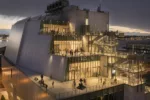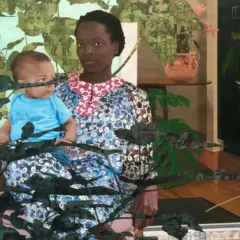Hacking for the common good could be the motto on Cory Arcangel‘s coat of arms. Surely he deserves one, The Nintendo Lord of Hacking whose heirs will populate the earth with open source tools for benign purposes.
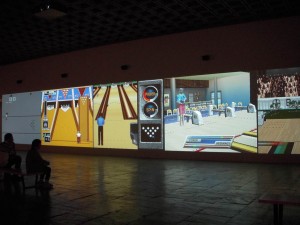
Arcangel’s DIY hacks of Atari, Nintendo and other video games, and his alterations of other pop culture consumer products do no harm. They subvert the corporate intent, but then that’s what good art should do, subvert somebody’s sacred cow and use it to point out something new. Mostly, what Arcangel gets at in his sweet show at the Whitney (up to Sept. 11) are the concepts of perfection and ownership. Of course perfection is a fantasy and ownership is a slippery concept in the Internet age so they’re both great idea for art.
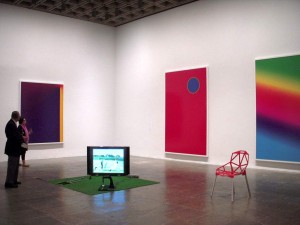
Arcangel’s video bowling and golf games are rigged for failure — the bowling balls are programmed to hit the gutter each time; the golf balls go into the rough no matter how hard you try. Games for Sisyphus, the un-winable activities play on forever, with “new low score” of 0 flashed on the screen repeatedly. It’s funny and poignant too. The bowling games in particular, projected side by side on the wall and with upbeat electronic video game music swelling as if for a bunch of winners, are full of downbeat grandeur.
This is the 33-year old artist’s first solo museum show and while he’s not trained as an artist (he went to Oberlin and studied classical guitar), and he’s self-taught as a programmer, he’s been a player in the art scene for years. His “Clouds” piece, a depopulated Super Mario Brothers game that shows only the passing clouds from the game’s background was included in the Whitney Biennial 2004.
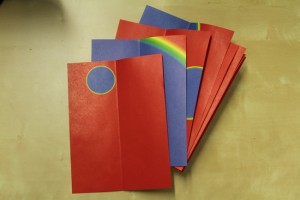
Because he’s all about open source, he’s a giveaway artist. And the brochure for the show, with an essay by the curator and 8 full color digital prints suitable for framing is a giveaway. The brochure has no staples, and as the artist says on his website “… that’s so you can take it apart, and have 8 FREE PRINTS. Enjoy!” If you can’t make it up to the Whitney to get the brochure, it’s available online as a pdf for DIY printing.
These small giveaway prints echo some large Photoshop prints that are in the show (photo above). The large prints are pristine and framed elegantly (not under glass) and sit there like mock-heroic color field paintings.
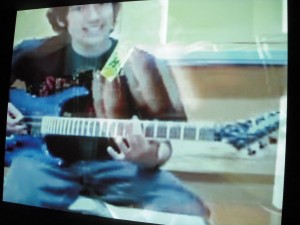
This is a show with a Zen-like point about life being a journey with some beauty, some pauses, repeats, and ultimately an ending. You can get that pretty quickly strolling the galleries. But even in this life without ecstasy, there is fun and humor. The YouTube guitar masters mashup video Paganini Caprice No. 5 (2011) reinvents the classical violin piece with a montage of snips from the YouTube, and it’s both mesmerizing to watch; and the sound, with the guitars emulating the violin’s upper reaches, both works well — and is very funny.
Also LOL great is the “Research in Motion (Kinetic sculpture #4) 2001, which programs a group of moving display shelves like those seen in the old Sharper Image stores (I’ve seen them in a cell phone store). They sway like a chorus line of hulu dancers–hypnotic and a little threatening and mostly just funny.
Arcangel’s ambition and his ability to take these old things and make them relevant in a new way they’d never been envisioned is great.
By the way, you are allowed to take photos and videos in the show, which, I have to believe, is dictated by the artist, whose open source philosophy trickles over to who owns images of his work–you, me, anybody.
After this noisy and vibrant show on the Whitney’s 4th floor it was like stepping into a spa downstairs on 2 in the quiet and lovely show about the Whitney’s founding collection, with some works hung salon-style, including paintings by the self-taught artist John Kane and the American regionalist Thomas Hart Benton. Sometimes a little old fashioned art is refreshing.
Photography at the Met
Cate joined us as we sped through the Met, which, on a Wednesday afternoon in June was jammed with visitors. We only had time for the two photo shows, and these two were worth the visit. After the Gold Rush, a show of contemporary photographs from the collection has some downbeat work in it. The title of the show is based on a mournful Neil Young song from 1970, a song about dimished expectations and wasted resources and opportunities.
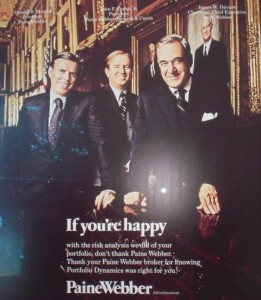
Hans Haacke’s “Thank You, Paine Webber” from 1979 is one with Young’s lyrics. The photo’s anger at the rich guys feels very contemporary in our post-Wall Street bailout and banks too big to fail era.
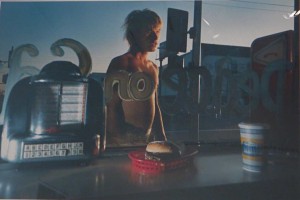
Phillip Lorca di Corcia’s 1991 series — sponsored by an NEA fellowship — features male prostitutes and drug addicts in Santa Monica. The artist collaborated with his subjects and negotiated a payment for them, which came out of his NEA funds. How subversive was that? Katy Grannan, likewise worked with her subjects posing people on the streets in Los Angeles and San Francisco in front of a stucco wall. The 2010 prints, large and not trapped under glass, capture anonymous people looking fragile and mysterious as well as glamorous.
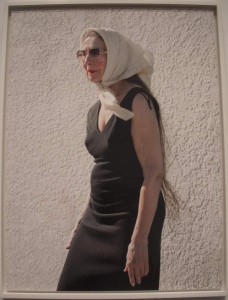
The other exhibit we saw was Night Vision–black and white photography from 1890s to the present, much of it from the 1940s and ’50s but some of it more recent (like the work by Japanese photographer Kohei Yoshiyuki showing people watching couples having sex in a park). From the rainy cobblestone streets of Paris to Weegee and Yoshiyuki, Robert Frank and even some Diane Arbus (works from the estate that are now in the Met’s collection), it’s a good show. All the works are small, all are framed and under glass, and Cate and I noticed how much harder it was to see the works in this show than it was to see the mostly not glassed-in works in the contemporary show.
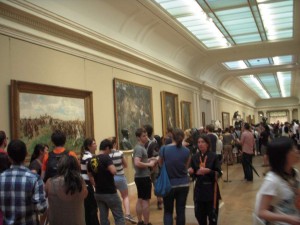 The corridor with Night Visions was filled with people waiting in line. We thought they were there to see the Richard Serra drawings which are nearby. Silly us. These people were waiting to see the Alexander McQueen exhibit, which is not in the Costume Institute downstairs but in the Contemporary section upstairs. Fashion as art, why not?
The corridor with Night Visions was filled with people waiting in line. We thought they were there to see the Richard Serra drawings which are nearby. Silly us. These people were waiting to see the Alexander McQueen exhibit, which is not in the Costume Institute downstairs but in the Contemporary section upstairs. Fashion as art, why not?


